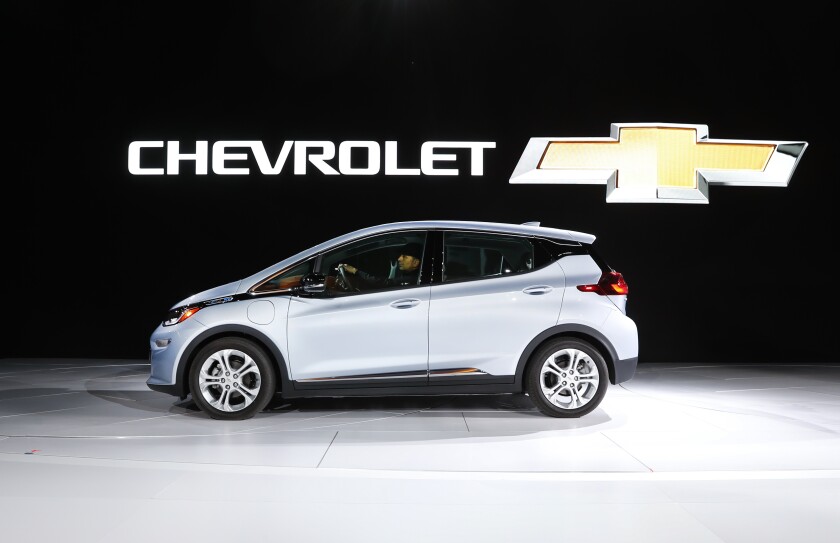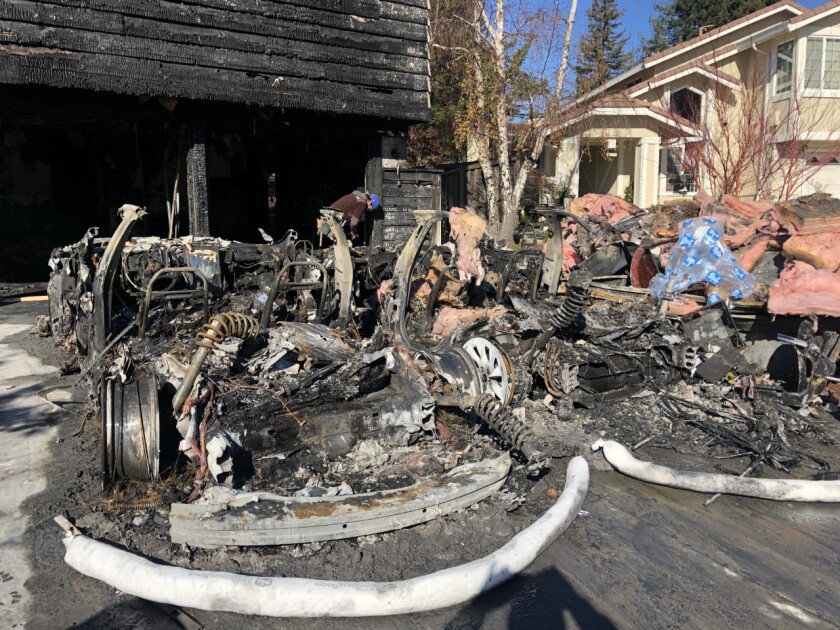It’s happened only in rare instances but some carmakers have been trying to figure out what’s causing their electric vehicles to catch fire — sometimes when the cars are getting their batteries recharged.
The most dramatic example happened eight months ago in San Ramon, where a blaze erupted in the garage of the home owned by Jorgen and Carolyn Vindum, where their two Teslas were parked. Their 2013 Model S 85 was charging overnight, next to their 2017 Model S 75, when alarms jolted the couple out of bed.
“I saw flames coming from the garage, going all the way up to the roof of the house,” Jorgen Vindum recalled. Once he and his wife were safely outside, Vindum called 911 at 5:39 a.m. Then, barefoot and in his pajamas, he recorded the fire on his smartphone.
“You can hear explosions from the cars and you can actually hear the horn go off on the second car,” he said. “The cars kept re-igniting.”
Vindum said the blasts blew the metal rollup doors off of the garage.
As first reported by the Washington Post, a fire inspection report lists problems in the thermal management system and a fault in the electrical system of the car getting charged as possible causes for the Dec. 30 blaze.
In a telephone interview with the Union-Tribune, Vindum said fire crews arrived in eight minutes and it took them about 20 to 30 minutes to douse the flames. Much of the home was gutted, and both Teslas were burned to a crisp. Vindum believes if anyone had been sleeping directly above the garage, they would have died.
The San Ramon fire is one of a number of instances involving electric vehicles, or EVs, equipped with lithium-ion batteries.
Last month, General Motors issued a second recall for nearly 69,000 Chevy Bolts after two cars that had been previously repaired caught fire. The carmaker said the root cause of the fires were “two rare manufacturing defects” in the battery cell of some Bolt EVs made between 2017 and 2019, Dan Flores of GM Corporate News Relations said in an email.

In this Jan. 9, 2017 file photo the Chevrolet Bolt is on display at the North American International Auto Show in Detroit. General Motors recalled some Bolts for a second time in July to fix persistent battery problems that can set the electric cars ablaze.
(ASSOCIATED PRESS)
“Out of an abundance of caution,” Flores said, owners should park their Bolts outdoors immediately after they are charged and drivers should not leave their vehicles charging overnight. GM has also called for drivers to limit the charge on the car to 90 percent and, when possible, avoid depleting battery range below 70 miles.
Hyundai, Ford and BMW have also issued recalls in the past year over risks that batteries could ignite when charging or overheating.
Six weeks ago, fire officials in suburban Philadelphia said a Tesla Model S Plaid, a new high-performance EV produced by the Elon Musk-owned carmaker, caught fire while the owner was at the wheel. The driver, through his attorneys, told CNBC he saw smoke coming from the back of the car and got out before the fire started.
Similar stories have been reported — one by a Tesla owner driving a 2015 Model S in November 2020 in Frisco, Texas and another in Los Angeles in 2018, whose wife said he “was barely moving in traffic” in his Model S along Santa Monica Boulevard.
Tesla did not respond to emails from the Union-Tribune asking the carmaker if it has determined what caused the incidents in San Ramon and suburban Philadelphia.
Tesla’s website includes a Vehicle Safety Report in which the carmaker says its EVs “are engineered to be the safest cars in the world.” The report also said between 2012 and 2020, “there has been approximately one Tesla vehicle fire for every 205 million miles traveled. By comparison, data from the National Fire Protection Association (NFPA) and U.S. Department of Transportation shows that in the United States there is a vehicle fire for every 19 million miles traveled.”
The NFPA itself was less declarative, saying there’s no clear answer whether EVs have more, less or the same propensity for fire than internal combustion engine vehicles.
“The problem right now is that when we track vehicle fires, there’s no way for fire departments or any reporting agency to specify whether it was a hybrid or electric vehicle versus an internal combustion engine vehicle,” said Michael Gorin, program manager for NFPA’s emerging issues team.
“There’s a traditional internal combustion engine vehicle fire on U.S. roadways just about every three minutes,” Gorin said. “And as of right now, there’s nothing to say that any electric vehicle is any more unsafe than a traditional vehicle.”
But firefighters have a different set of challenges when dealing with EV fires and that is largely due to the lithium-ion batteries that power them. The banks of energy cells in an EV or hybrid vehicle are much larger than those in your cellphone or laptop.
When a short circuit in an EV battery occurs — whether in a crash or overheating while it is getting charged — the cell case can burst. When one cell ignites, it can cascade to other cells, leading to what is called thermal runaway, and cause a fire.
That can result in intense blazes that can take a long time and lots of water to put out.
For example, NBC News reported on an crash outside Houston in April that killed two people in a Tesla Model S that caught fire. It took firefighters seven hours and 28,000 gallons of water — an amount the department normally uses in one month — to douse the blaze because the car kept reigniting. The NBC report said it takes about 300 gallons of water to put out a typical fire involving an internal combustion car.
Tesla’s own Emergency Response Guide says it can take between 3,000 to 8,000 gallons of water to fully extinguish and cool down a battery fire.
Gorin said the amount of water largely depends on whether firefighters can get right to the source of the fire.
“One of the challenges is you have this large battery system in the vehicle that’s encased in steel to protect it and that’s an engineering design that’s been done for obvious reasons to protect the undercarriage of the vehicle,” Gorin said. “With these batteries, (firefighters) can’t get that water to the battery itself, so they’re just cooling the casing that’s around the battery. That’s why you might hear stories where there’s varying degrees of water being put on a fire because … they’re not getting water directly into it.”
Vindum said when crews arrived at the fire at his house in San Ramon the heat was so severe they could not walk up the driveway. “Both my wife and I got sunburned to the point where our noses peeled the next day from the heat,” he said.
The San Diego area has one of the highest rates of EV adoption in the country and in June, the San Diego Fire-Rescue Department’s Training and Education Division sent out an online training drill about the “challenges associated with fires” in hybrid and electric vehicles. All personnel are required to log in and read the document. A Fire-Rescue spokeswoman said station captains also routinely discuss training drills with their crews.
“Although fires not involving the batteries can be fought like any other vehicle fire, rescuers should not make contact with any high voltage components during overhaul,” the two-page memo said. “If the battery does catch fire, is exposed to high heat, or damaged, be prepared to use much more water than you would use for other vehicle fires.”
The drill also mentioned that towing services need to be advised to store the vehicles at least 50 feet from other vehicles or structures in their yards due to the possibility of reignition.

The remains of a pair of Teslas that had been parked in the garage of Jorgen and Carolyn Vindum of San Ramon.
(Jorgen Vindum)
Bill Lamb, a 76-year-old San Diego retiree with experience fighting fires on ships and helicopters in the Navy and implementing mitigation measures at correctional facilities in Maryland, says he is “a thousand percent” in favor of transitioning away from internal combustion engines but worries about EVs catching fire in underground parking garages.
“There’s a high degree of probability that it’s going to continually re-ignite,” Lamb said. “So the concern is if you have an EV fire in an underground garage where there are multiple cars sitting, that fire is very difficult and dangerous to put out” as first responders battle flames, smoke and potentially toxic fumes in enclosed quarters while also trying to keep other cars from igniting.
Lamb said as EV adoption continues, he thinks safety standards will advance. In the meantime, “fortunately, EVs don’t catch on fire that often,” he said. “It’s just that if you have one that catches on fire in the wrong place, then I think you have a potential for disastrous results and in an enclosed garage under a medium-rise or high-rise residential building is not where you want to be.”
Coronado resident Jon Sinton received a recall notice on his 2017 Chevy Bolt. As GM recommends, he and his wife no longer charge the car overnight while they sleep. But that means they have to pay a higher electricity rate of 31 cents per kilowatt-hour instead of the cheaper, overnight rate of 9 cents per kilowatt-hour on their San Diego Gas & Electric Time of Use program.
Sinton said while it’s “really disheartening” that he has a Bolt “whose resale value is now zero and a car whose functionality has been greatly reduced by the fact that you can’t charge it up full and you can’t drive it to empty,” he has some sympathy for the carmaker.
“They’re pioneers in electric vehicles and obviously they don’t have a 100 percent success rate here,” Sinton said. “Like pioneering anything, you’re going to have issues.”
Eight months after the fire in his garage, Vindum said Tesla has not contacted him for information to help them figure out precisely what happened.
“That has been disappointing,” he said. “Who knows what is causing this but if they don’t know, they should certainly examine it and if they do know, I think they should tell us. Either recall them or fix them.”
With a payout from their car insurance, Vindum and his wife and have purchased a new vehicle — a gasoline-powered Audi A4.
Despite it all, Vindum said he would still consider buying another electric vehicle, although he would not charge it in his garage.
“I think (EVs are) the future,” the retired mechanical engineer said. “I believe in renewable energy. I spent seven years designing some of the biggest solar systems in the country back in the ‘80s and ‘90s.”
Sinton feels the same way.
“It’s where we’re headed,” he said. “We’re environmentally concerned. We’re obviously living in a state with tremendous fire problems and we’re equally concerned about climate change. Also, I think that because these events are rare in the population of electric vehicles, you don’t have to be completely frightened by it.”
